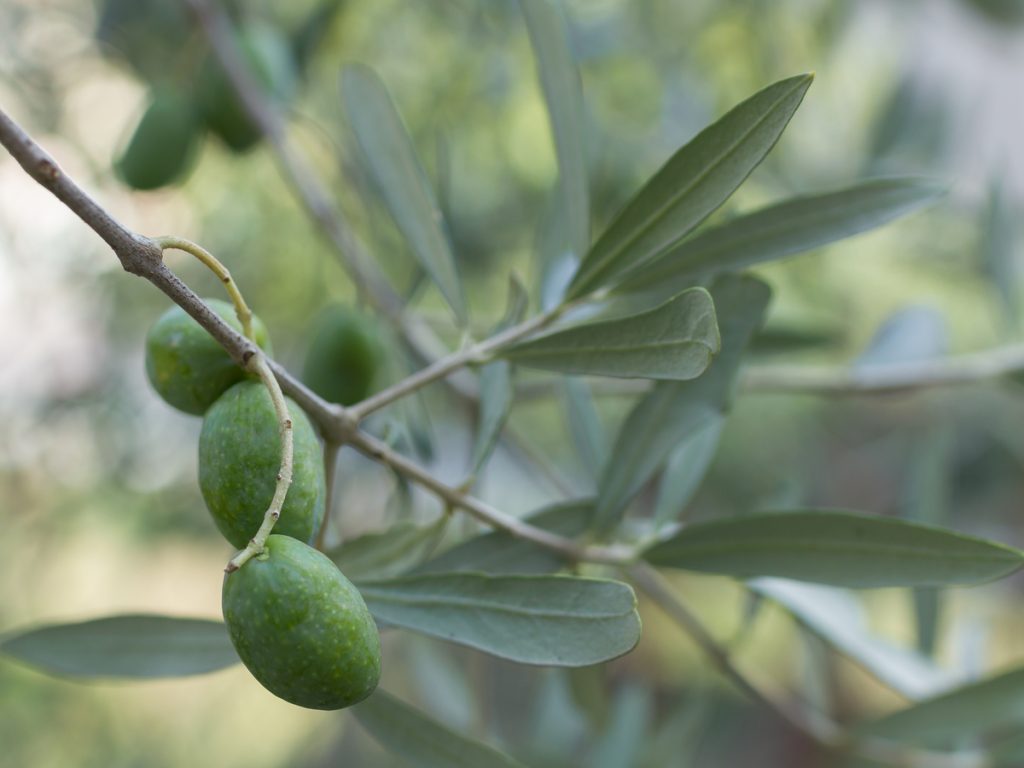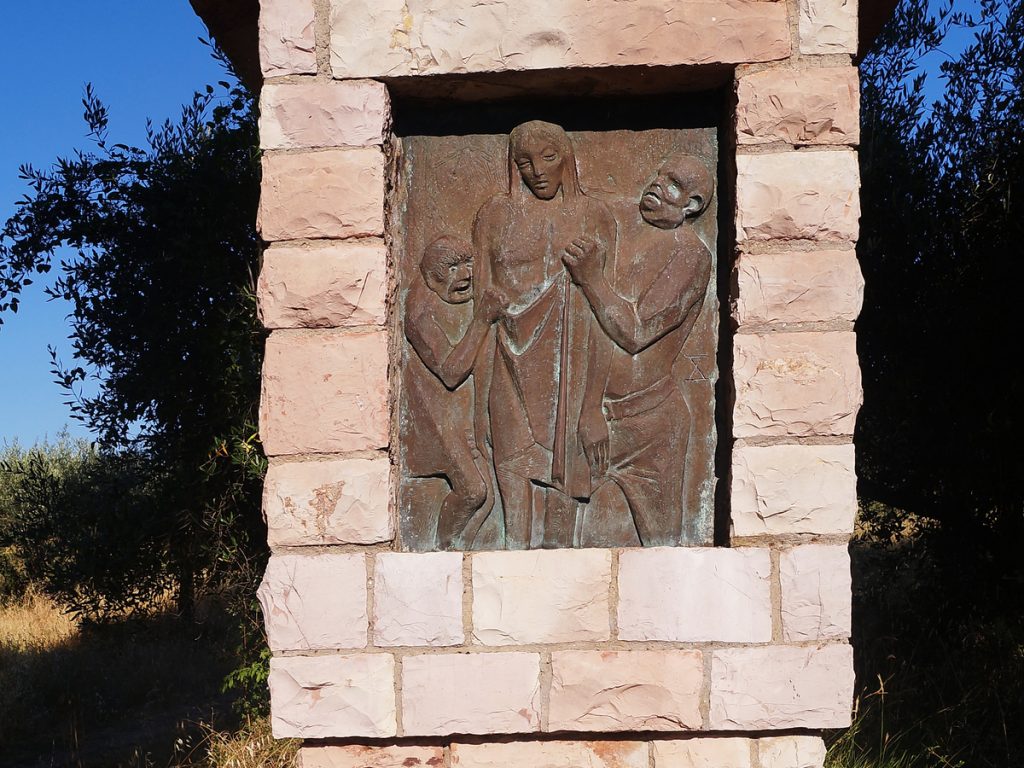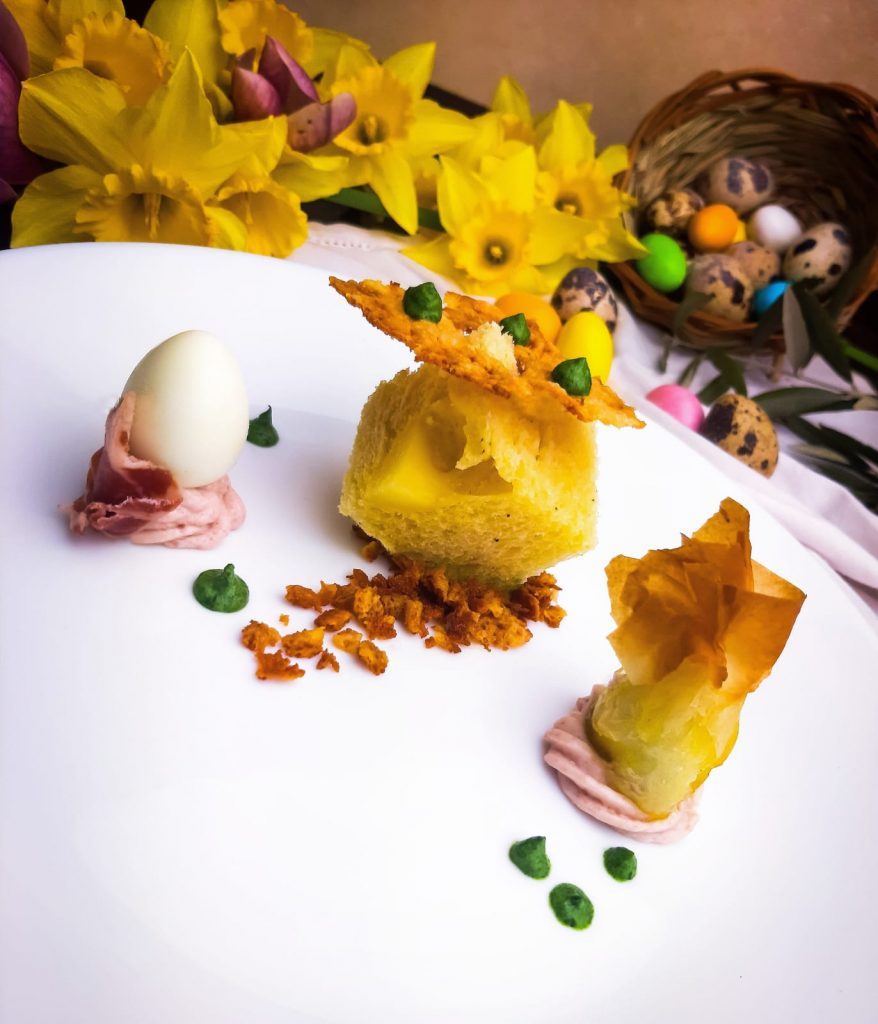Torta di Pasqua su crumble di pecorino e la sua cialda. Salsa di bietoline e uova di quaglia croccanti su mousse di ciauscolo e chips di capocollo.
Pasqua è la principale festività cristiana e la Settimana Santa ne scandisce le tappe di una liturgia molto importante e sentita. Numerose le fasi salienti della Settimana Santa, si comincia la Domenica delle Palme, con la messa e la benedizione dei ramoscelli di ulivo, e si prosegue poi il Venerdì Santo, giorno della Via Crucis, per terminare con il Lunedì dell’Angelo, in ricordo dell’incontro del messaggero con le donne giunte al sepolcro vuoto.
Scroll down to read this recipe in English.

Riti e tradizioni, che nei piccoli borghi trovano la loro espressione migliore, quella più autentica e dal fascino antico, fatta di processioni, rievocazioni storiche e cucine tradizionali. La più sentita delle ricorrenze gastronomiche è la colazione del giorno di Pasqua, una tradizione che esiste da tempo immemore che si può considerare la promotrice dei più moderni brunch. Una tavola colma di prelibatezze dalle prime ore del mattino che arriva fino all’ora di pranzo, volta a festeggiare la fine del lungo digiuno quaresimale.
Un momento molto sentito dalle famiglie italiane che, come sempre, a tavola onorano al meglio le feste con preparazioni che sono un trionfo di sapori, dolci e salati ognuno con il suo valore simbolico. Non possono mancare le uova benedette, simbolo della resurrezione; la colomba, che rappresenta lo spirito santo ma anche agnello, carciofi, formaggi e i salumi, quelli di breve stagionatura, preparati a Gennaio e “aperti” la mattina di Pasqua. Ogni ingrediente racchiude una perfetta e secolare coincidenza tra i ritmi della natura e quelli del calendario liturgico.

Fra le tante ricette c’è la pizza o torta di Pasqua che accomuna gran parte delle regioni. Dalle mie parti si chiama “Crescia”, questo nome sembra far riferimento alla crescita dell’impasto determinata dalla lievitazione in forno che le conferisce la tipica forma a panettone. Con ogni probabilità la crescia è nata nei monasteri in epoca medievale; assume forme e nomi diversi a seconda delle zone ma prevede sempre le stesse materie prime.
La preparazione della torta di pasqua rimanda alle attività domestiche connesse alla Settimana Santa, in un interessante parallelismo fra il calendario liturgico e l’organizzazione della casa. Le torte vengono preparate nei giorni antecedenti la Pasqua, un tempo servivano per l’uso di famiglia, per farne dono a parenti, amici, omaggio di fatto obbligato dei contadini per i “padroni”, ma anche al prete, al medico, alle “autorità”.
Venivano preparate in grandi quantità; la raccolta delle uova iniziava molti giorni prima della preparazione, venivano poste in cesti e tenute al fresco in cantina. La lavorazione delle torte coinvolgeva tutta la famiglia, anche gli uomini perchè occorreva grande forza fisica per l’impasto. Nelle vecchie e fredde abitazioni, uno dei problemi era la lievitazione che iniziava nel cuore della notte e un membro della famiglia ne sorvegliava l’andamento.
Anche la cottura al forno era un rito, spesso collettivo, sia nei forni delle case contadine, dove talvolta si riunivano per la cottura più famiglie, sia in quelli collettivi o comunali, che fino agli anni ’50-60 erano attivi in quasi tutti i paesi. Era pratica comune, una volta chiuso il forno, tracciare su di esso il segno della croce, beneaugurante per una buona lievitazione, motivo di vanto tra le donne. Anche i fornai di città ospitavano dietro un piccolo compenso, le teglie delle massaie, che le contrassegnavano, imprimendo un marchio per riconoscerle una volta cotte. Nei giorni precedenti la Pasqua era un via vai di gente con recipienti che girava per strade che erano impregnate del profumo delle torte.
Un pane dal significato profondo di condivisione comunitaria che oggi si può trovare già pronto da fornai e pasticceri, ma molte famiglie non rinunciano comunque a prepararlo in casa come vuole questa bella tradizione che unisce intere famiglie e paesi nella preparazione di questa suntuosa colazione che vede sforgiare le tovaglie più belle, quelle gelosamente custodite nel cassettone della nonna, cestini colmi di uova sode e tante pietanze ricche di gusto e di storia.
Il mio piatto è un pò una sintesi di tutto questo, una versione moderna della colazione pasquale, stravolta nelle forme e nelle dimensioni ma che racchiude tutti i sapori, i profumi e gli ingredienti della tradizione, rielaborati in un piatto gourmet di fatto adatto ad ogni portata e ad ogni ricordo. Buona Pasqua!

Torta di Pasqua
Ingredienti:
500 gr di farina 0
200 gr Parmigiano reggiano
50 gr Pecorino romano
100 gr Groviera
100 gr Burro
5 Uova
25 gr Lievito di birra fresco o 7 gr secco
100 ml latte intero
8 gr di Sale
q.b. burro e farina per gli stampi
Procedimento:
Per prima cosa, sbattete le uova con una frusta fino a renderle spumose, continuando a mescolare, aggiungete in ordine; i formaggi grattugiati, il burro fuso tiepido, il sale, il lievito sciolto nel latte ed infine la farina. Lavorate bene fino a rendere l’impasto liscio ed omogeneo. Successivamente imburrate e infarinate gli stampi, scrollare la farina in eccesso. Poi dividete l’impasto in due parti e ponetelo negli stampi. A questo punto tagliate la groviera e conficcatela nell’impasto, non troppo vicina ai bordi. Coprite con un canovaccio e lasciate riposare fino a far raddoppiare di volume, circa 3 ore. Infornate a forno caldo a 200° e dopo circa 15 minuti coprite con un foglio di alluminio. Proseguite la cottura in questo modo per altri 30 minuti. Sfornate e lasciate raffreddare.
Spuma di ciauscolo
Ingredienti:
100 gr di ciauscolo
100 gr di formaggio spalmabile o ricotta
q.b. erba cipollina fresca
q.b. prezzemolo fresco
1 cucchiaio di succo di limone
1 cucchiaino di olio di oliva extravergine
Procedimento:
Togliete la pelle al salume, mettetelo nel bicchiere del frullatore insieme al formaggio, al succo di limone, al cucchiaino di olio, ad alcune foglie di prezzemolo e qualche filo di erba cipollina. Azionare il frullatore fino ad ottenere un composto piuttosto denso, fermo, ma cremoso. Riempire una sac a poche con la mousse di ciauscolo così ottenuta e distribuire nel piatto come base per le uova.
Uova di quaglia croccanti
Ingredienti:
q.b. Olio extravergine di oliva
q.b. Sale
q.b. Pepe
q.b. Pasta fillo
Procedimento:
Ritagliare dai fogli di pasta fillo 2 rettangoli per ogni uovo, spennellare con una emulsione di acqua e olio e sovrapporli perpendicolarmente. Al centro porre l’uovo sodato e aggiustato di sale e pepe. Unire i vertici dei rettangoli di fillo e chiudere come un sacchetto con l’aiuto di una pinza. infornare a 170°C ventilato per circa 10 minuti in posiziine verticale con l’aiuto di un piccolo supporto. Quando la pasta fillo risulta leggermente dorata e croccante, togliere dal forno. L’uovo è pronto.
Crema di bietoline
Ingredienti:
100 gr RICOTTA VACCINA
200 gr Bietoline
20 gr Parmigiano grattugiato
1 Cipollotto
q.b. Olio extravergine di oliva
q.b. Sale
Procedimento:
Mondate il cipollotto e affettatelo finemente. Poi raccoglietelo in una padella e fatelo appassire con un filo di olio. Mettete le bietoline e coprite con un coperchio fino a che non diventano morbide. Salate, mescolate, poi levate il coperchio e fate asciugare. Infine spegnete e fate intiepidire. Raccogliete le bietoline cotte in una ciotola pulita insieme al parmigiano e alla ricotta, frullate il tutto con un frullatore a immersione. La salsa è pronta per accompagnare il nostro piatto
Easter cake on Pecorino crumble and wafer . Chard sauce and crispy quail eggs on ciauscolo mousse and capocollo chips.
Easter is the main Christian holiday and Holy Week marks the stages of a very important and heartfelt liturgy. It starts on Palm Sunday, with the mass and the blessing of the olive branches, and continue through Good Friday, the day of the Via Crucis, to end with Easter Monday that celebrate the Angel’s meeting with the women who found the empty tomb.
The most authentic and charming rites and traditions – processions, historical re-enactments and traditional cuisines – find their best expression in small villages. The most heartfelt of the gastronomic recurrences is the breakfast on Easter day, a tradition that has existed since time immemorial and that can be considered the precursor of modern brunches. A table full of delicacies from early morning until lunchtime to celebrate the end of the long Lenten fast.
A very special moment for Italian families that, as always, at the table best honor the holidays with preparations that are a triumph of flavors, sweet and savory, each with its own symbolic value. The blessed eggs, symbol of the resurrection, cannot miss; the “Colomba” (Easter Dove), which represents the holy spirit, but also lamb, artichokes, cheeses and cold cuts… those of short maturation, prepared in January and “open” on Easter morning. Each ingredient contains a perfect and centuries-old coincidence between the rhythms of nature and those of the liturgical calendar.
Among the many recipes there is the pizza or Easter cake shared by most Italian regions. Where I come from it is called “Crescia”: this name seems to refer to the dough growth (crescita in Italian) due to the leavening in the oven that gives it the typical panettone shape. In all likelihood, the crescia was born in the monasteries in medieval times; it takes different forms and names depending on the area but always comes with the same raw materials.
The preparation of the Easter cake relates to domestic activities during the Holy Week, in an interesting parallelism between the liturgical calendar and the organization of the house. The cakes are prepared the days before Easter; in the past they were for family use, as a gift to relatives, friends, a de facto obligatory homage of the peasants to the “masters”, but also to the priest, the doctor, the “authority”.
They were prepared in large quantities. The collection of eggs began many days before preparation; they were placed in baskets and kept cool in the cellar. The making of the cakes involved the whole family, even men because great physical strength was needed for the dough. In old and cold houses, one of the problems was the leavening: it began in the middle of the night and a family member had to monitor its progress.
Even cooking in the oven was a ritual, often collective. It could take place both in the ovens of peasant houses – where sometimes several families gathered for cooking – then in collective or municipal ones, which until the 1950s-1960s were active in almost all villages. It was common practice, once the oven was closed, to draw the sign of the cross on it, auspicious for a good leavening, a source of pride among women. Even the bakers of the city hosted, for a small fee, the trays of the housewives, who marked them in order to recognize the cake once was cooked. The days before Easter were a coming and going of people with containers that wandered through streets impregnated with the scent of cakes.
I was a bread with a profound meaning of community that today can be bought already made by bakers and pastry chefs. However, many families still continue to prepare it at home as dictates this beautiful tradition. Entire families and villages are united in the preparation of this sumptuous breakfast that sees the showing off of the most beautiful tablecloths – those jealously guarded in the grandmother’s dresser – baskets full of hard-boiled eggs and many dishes rich in taste and history.
My dish is kind of a synthesis of all this, a modern version of the Easter breakfast, distorted in shape and size but which contains all the flavors, aromas and ingredients of tradition, reworked into a gourmet dish suitable for every course and every memory. Happy Easter.
Easter cake
Ingredients:
500 gr of flour 0
200 gr Parmesan cheese
50 gr Pecorino romano cheese
100 gr Gruyere
100 gr butter
5 eggs
25 gr fresh beer yeast or 7 gr dry
100 ml whole milk
8 gr of salt
Butter and flour for the molds q.s.
Method:
First, beat the eggs with a whisk until frothy. Continuing to mix, add in order: grated cheeses, melted butter left to cool, salt, yeast dissolved in milk and finally flour. Work well until the dough is smooth and homogeneous. Then grease and flour the molds, shake off the excess flour. Then divide the dough into two parts and place it in the molds. At this point, cut the Gruyere cheese and stick it into the dough, not too close to the edges. Cover with a cloth and leave to rest until doubled in volume, about 3 hours. Bake in a hot oven at 200° and after about 15 minutes cover with aluminum foil. Continue cooking in this way for another 30 minutes. Remove from the oven and let cool.
Ciauscolo mousse
Ingredients:
100 gr of ciauscolo
100 gr of spreadable cheese or ricotta
Fresh chives q.s.
Fresh parsley q.s.
1 tablespoon of lemon juice
1 teaspoon of extra virgin olive oil
Method:
Remove the skin from the salame, put it in the glass of the blender together with the cheese, lemon juice, a teaspoon of oil, some parsley leaves and a few strands of chives. Operate the blender until the mixture is rather thick, firm, but creamy.
Fill a pastry bag with the ciauscolo mousse thus obtained and distribute on the plate as a base for the eggs.
Crispy quail eggs
Ingredients:
Extra virgin olive oil q.s.
Salt q.s.
Pepper q.s.
Phyllo dough q.s.
Method:
Cut out 2 rectangles for each egg from the sheets of phyllo dough, brush with an emulsion of water and oil and overlap them perpendicularly. In the center place the hard-boiled egg seasoned with salt and pepper. Join the vertices of the wire rectangles and close like a bag with the help of pliers. Bake at 170° C ventilated oven for about 10 minutes in a vertical position with the help of a small support. When the filo pastry is slightly golden and crunchy, remove from the oven. The egg is ready.
Chard cream
Ingredients:
100 gr vaccine ricotta
200 gr Swiss chard
20 gr grated Parmesan
1 spring onion
Extra virgin olive oil q.s.
Salt q.s.
Method:
Clean the spring onion and slice it finely. Then put it in a pan and let it wither with a drizzle of oil. Add the chard, put the lid on and let it soften. Add salt, stir, then remove the lid and let it dry. Finally turn off and let it cool down. Collect the cooked chard in a clean bowl together with the parmesan and ricotta, blend everything with an immersion blender. The sauce is ready to accompany our dish.
Hungry for more recipes? Try making these dishes:
Sformato di roveja
Baci di Romeo e Giulietta
Scallops with Thyme and Saffron Potato Cream



